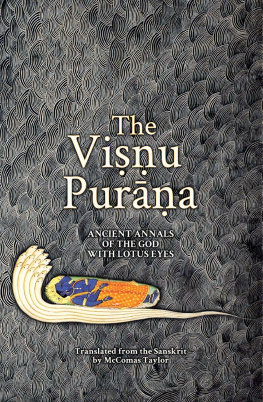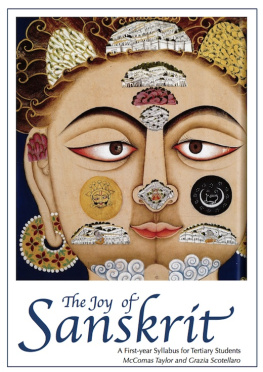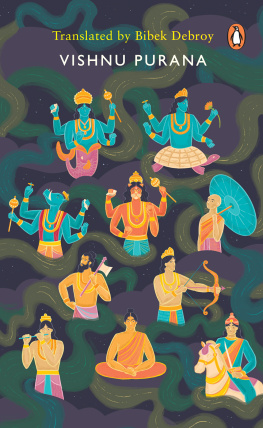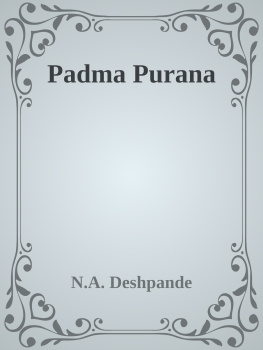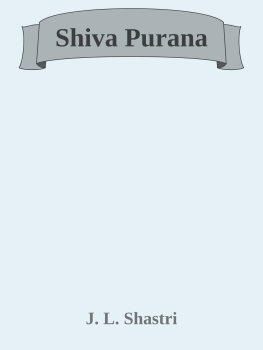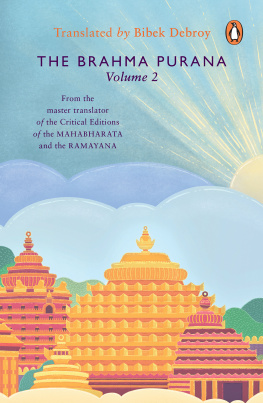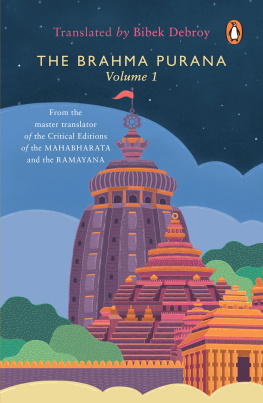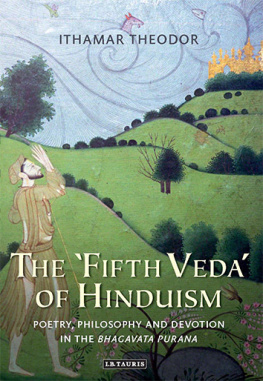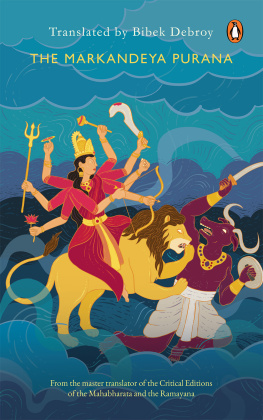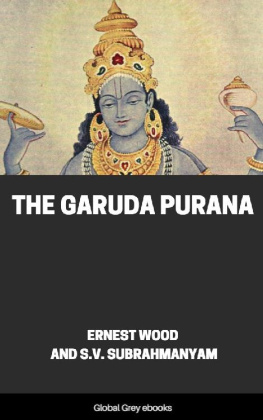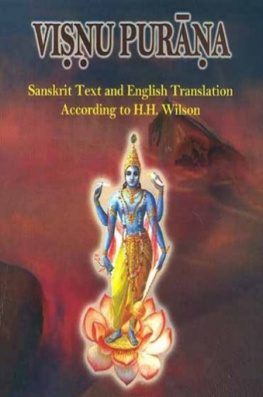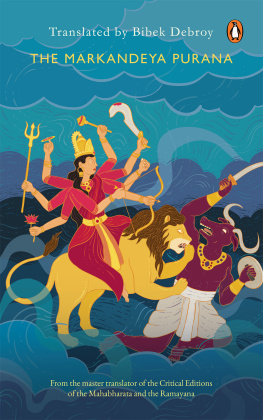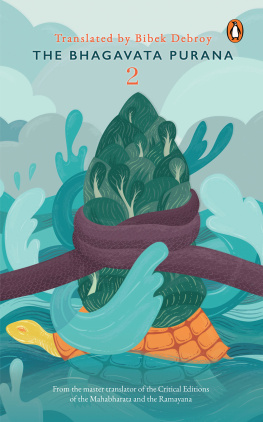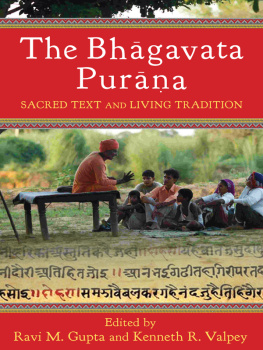The Viu Pura
Ancient Annals of the God with Lotus Eyes
Translated from the Sanskrit by McComas Taylor
For my grandchildren

Published by ANU Press
The Australian National University
Acton ACT 2601, Australia
Email: anupress@anu.edu.au
Available to download for free at press.anu.edu.au
ISBN (print): 9781760464400
ISBN (online): 9781760464417
WorldCat (print): 1247155624
WorldCat (online): 1247154847
DOI: 10.22459/VP.2021
This title is published under a Creative Commons Attribution-NonCommercial-NoDerivatives 4.0 International (CC BY-NC-ND 4.0).

The full licence terms are available at creativecommons.org/licenses/by-nc-nd/4.0/legalcode
Cover design and layout by ANU Press
Cover image: Vishnu Reclining on Ananta. From Sage Markandeyas Ashram and the Milky Ocean, c. 17801790. Mehrangarh Museum Trust.
This edition 2021 ANU Press
Preface
Viu is a central deity in the Hindu pantheon, especially in his manifestation as the seductive cattleherding youth, Ka. The puras are a genre of sacred texts, which, as the Sanskrit name implies, are collections of narratives from long ago. The Viu Pura is thus an ancient account of the universe and a guide to life, which places ViuKa at the centre of creation, theology and reality itself.
This text, composed about 1,500 years ago, provides a comprehensive and accessible introduction to the most important themes and narratives that constitute the Hindu imagination: the cyclical creation and destruction of the universe, the origin of gods and mortals, the peopling of the world and the structure and conduct of ideal brahminical society.
The Viu Pura describes the trials of exemplary devotees, the existential struggles between gods and demons and the exploits of legendary cultural heroes. It also contains many ecstatic songs of praise for the deity. The ever-popular accounts of Kas love games with the cattle-herding girls of Vdvanawhich have proliferated in literature, dance, song and visual arts over the millenniaare found here in authoritative form.
This introduction provides background information to help non-specialist readers understand, appreciate and, most importantly, enjoy the Viu Pura. It begins by describing the puras as a genre, noting the difficulty of assigning specific dates and authors to individual texts. This is followed by an outline of the relationship between the Viu Pura and other master texts of the Sanskritic archive.
I then outline the theology of the Viu Pura, describing the place of the deity in the Hindu pantheon, along with his avatrashis physical manifestations who have crossed down into the worldincluding Ka. To assist readers in navigating the puric thought-world, the various classes of divine, semi-divine and mortal beings that inhabit these accounts are described.
I will briefly discuss the different elements that make up the text, beginning with the overall framing narrative, the verse and prose sections, the embedded subnarratives, the extensive genealogical lists and the all-important songs of praise.
The Viu Pura is divided into six parts (aa) or books, which I have labelled for convenience: Creation, The World, Society, The Dynasties, Ka and Dissolution. Each book is summarised to provide the reader with a convenient overview of the entire work. I conclude this introduction with a few notes on the various Sanskrit versions of the Viu Pura, earlier translations and an explanation of how I approached some of the dilemmas faced by every translator, especially those working with Sanskrit texts.
Specialist readers, and indeed non-specialists who do not like reading introductions, may prefer to jump straight into the translation itself. For those encountering this style of narrative for the first time, there are several easy entry points. These include the story of the demon prince Prahlda, who wins liberation (1.1620); the story of Saubhari, a sage who lived underwater and used his magic powers to marry 50 sisters but ended up with more problems than he could handle (4.2); and the story of how Ka subdued the serpent Kliya, who lived in the Yamun River (5.7).
References to the Viu Pura are given in the form of book and chapter numbers or book, chapter and verse numbers.
Acknowledgements
Sweta Prajapati of the Oriental Institute at the Maharaja Sayajirao University of Baroda provided the original impetus for this project. Ulrich Timme Kragh generously hosted me at Adam Mickiewicz University in Poznan, Poland, as part of the Narrative Modes of Historical Discourse in Asia Project. During two sabbaticals, Tim taught me the true meaning of Danish hygge. Simon Brodbeck of the University of Cardiff generously shared the invaluable expertise he gained in the process of translating the Harivaa. Peter Schreiner, whose German translation was always at my elbow during my labours, served as an absent guide and mentor. Mark Allon, Greg Bailey, Raj Balkaran, Adam Bowles, John and Mary Brockington, Beth Rohlman, Adheesh Sathaye and Christiane Weissbach-Berger have all shared this journey in various ways. I gratefully acknowledge the interest, guidance and encouragement provided by all these kind colleagues. I am especially grateful to the two anonymous referees engaged by ANU Press, whose meticulous and critical attention has saved me considerable embarrassment. Thanks also to Jan Borrie for her punctilious copyediting and proofreading. All remaining errors are, of course, my own.
Glossary
dityas | deities descended from Aditi |
apsarases | semi-divine female beings |
avatras | the physical manifestations of a deity in this world |
craas | a class of heavenly singers |
Daityas | demons descended from Diti |
Dnavas | demons descended from Danu |
gandharvas | semi-divine male beings |
guhyakas | demons, similar to rkasas |
guas | the three constituent qualities of the universe |
kinaras | a class of semi-divine beings |
kimpuruas | a class of semi-divine beings |
katriyas | the community of warriors |
kmas | a class of demons |
mahat | the fundamental element, greatness |
Manus | legendary rulers of the world |
Maruts | wind gods |
ngas | semi-divine serpents |
picas | flesh-eating demons |
Pramathas | a class of demons in the service of iva |
rkasas | night-ranging demons |
sasra | the cycle of life, death and rebirth |
siddhas | highly accomplished seers with semi-divine powers |
rddha | a ritual to sustain deceased relatives in the afterlife |
dras | the community of servants |

